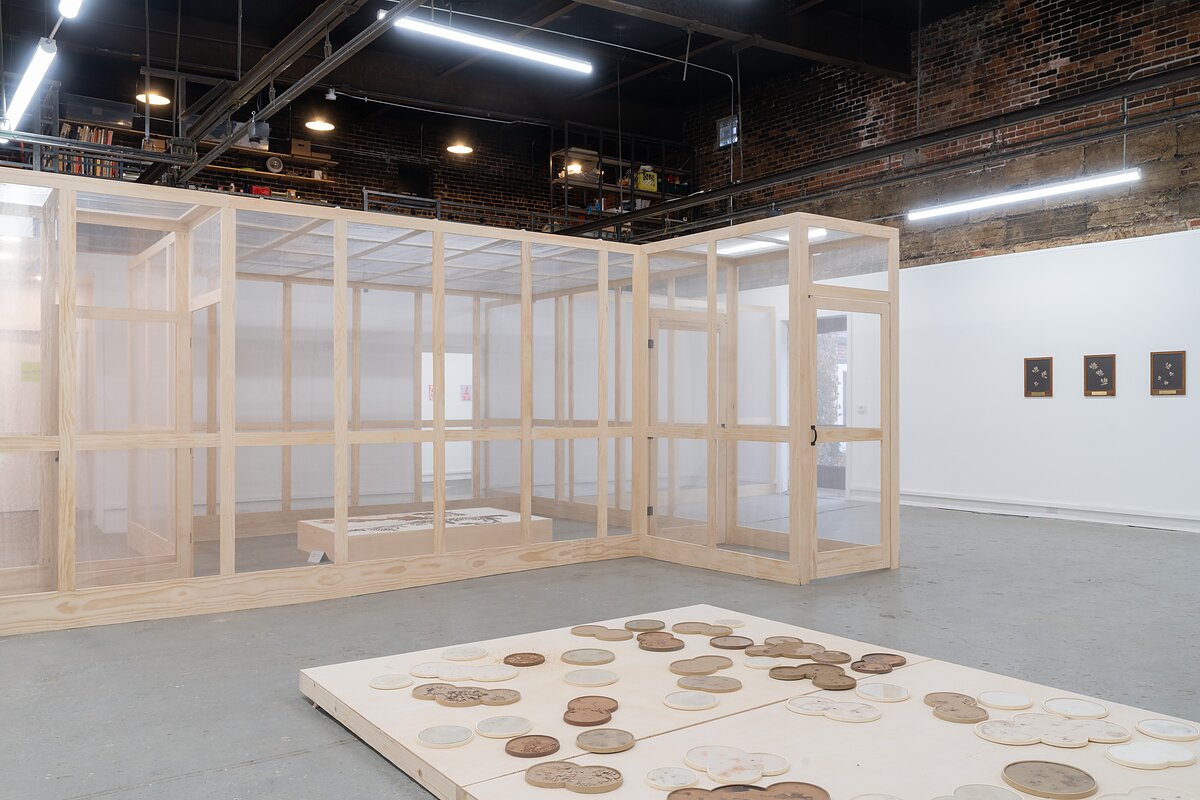Artist TJ Shin De-Sanitizes Natural History
In The Vegetarian, Han Kang’s 2007 novel, a woman’s descent into insanity is flourished by a primal desire to purge herself of humanity; to become flora as a rapturous rejection of mankind’s insatiable and often violent impulses toward consumption, extraction, and prescription. “Leaves are growing out of my body, roots are sprouting out of my hands,” utters Kang’s main character, Yeong-hye, to her sister during one pivotal scene. “They delve down into the earth. Endlessly, endlessly…yes, I spread my legs because I wanted flowers to bloom from my crotch; I spread them wide…”
Like its titular text, TJ Shin’s recent exhibition “The Vegetarian: The Swamp, The Swarm & the Cross,” at the Buffalo Institute for Contemporary Art (BICA), blurs existing moralizing prescripts when it comes to colonial dealings with the natural world. While Kang’s vessel for such interrogation is mental illness, Shin finds their muse in malaria.
Wafts of smokey vegetal incense and a low droning hum (tuned to a frequency often claimed to repel mosquitoes with little effective evidence) dampen the senses as viewers enter BICA’s gallery space and into a labyrinth of white mesh. Reminiscent of Do Ho Suh’s gossamer installations, Shin’s Architecture of Sanitation (Silver-Roll) (2022) is a recreation of the barracks created for non-white laborers tasked with purging the land of mosquitos during the construction of the Panama Canal in the early 20th century. The work’s translucent walls are made of mosquito netting; a spectral safeguard against a torturous and practically inevitable disease.
A screen door opens into a small room, where viewers encounter the source of the smell—Shin’s Untitled (100 days of solemnity) (2022). Arranged in a mycelial pattern on a low floor plinth, a smoldering network of incense made from mugwort transfected with Shin’s DNA rests on a chalk-white bed of diatomaceous earth. Recalling rituals of cremation by merging their own genetic material with the anti-malarial weed, Shin binds themself to this storied plant as it burns slowly against a snowy substrate of insecticidal fossil dust. In doing so, the artist becomes a fumigatory agent, or a weapon of sanitizing purity and cleanliness.
Architecture of Sanitation (2022) empties out into a larger exhibition space, where a series of haunting sepia prints hang. Titled Breath of Preservation (2022), the laser-etched collages layer images of anti-mosquito laborers in the field with natural history entries and documents tracing the development of fungicides, insecticides, Agent Orange, and other weapons employed in the war against nature. Echoing the burning incense in the other room, burn holes and tears embellish these images like bruises or bug bites, rendering them only partially legible histories. Such eradicating weapons were developed for colonial ends through colonial means, dependent on the obfuscated suffering of BIPOC laborers and without any desire to preserve or understand ecological balance. The land and its inhabitants are often only understood through the lens of the colonizer and seldom the colonized.
Below these prints and spread out on another floor platform are an array of ceramic Petri dish-like forms, some of which have seemingly mutated as cells do during mitosis. Staining these plates are bacteria-like blooms of rust, gray, black, and gold that have been rendered through botanicals turned into crystalline, branching dyes by the artist’s urine. Like Andre Serrano’s controversial Piss Christ (1987), Shin uses this abjectified bodily medium as a vessel for beauty and even possible redemption. For Serrano, urine baptizes an image of Christ in amber: salvation via religion. For Shin, urine is an active ingredient in chemical processes that mimic the search for curative solutions: salvation via science.
In English, the words “sanity” and “sanitation” share the Latin root “sanus,” meaning “health.” Like their inspiration Han Kang, Shin hints at how rooting concepts of cleanliness and reason with a vague sense of well being and “goodness” can create channels for violence on personal and systemic scales. The Vegetarian, both as novel and exhibition, looks to dirty, to infect, and to stain in order to come to a decolonized, relational understanding of nature.
Further smudging the lines between abjection and purity, as luck would have it, a small leak in BICA’s ceiling incidentally lends an occasional drip of water cascading down onto one of Shin’s Petri dish sculptures. As it crashes down from the roof, the drip slowly erodes the clay plate in steady plinks. What is ordinarily an unwanted taboo agent of chaos in the sanctified, sanitized space of the gallery is welcomed by Shin as an opportunity to disengage our biases; what was once deemed an undesirable horror is accommodated and allowed to simply be.
Shannon Lee is a writer and the current editor of The Amp.









